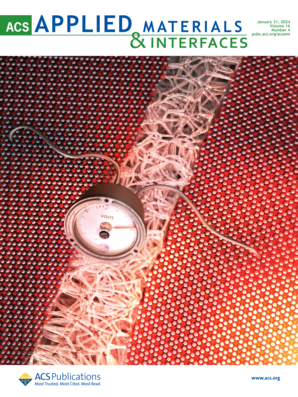可见光下控制细菌生长的MOF/CNF生物纳米复合膜的调制光电特性
IF 8.3
2区 材料科学
Q1 MATERIALS SCIENCE, MULTIDISCIPLINARY
引用次数: 0
摘要
本文报道了通过接枝芳香分子调节MIL-125-NH2纳米粒子光电性能的实验和理论研究。用3,4-二羟基苯甲醛(DBA)修饰MIL-125-NH2后,带隙能量降低了23%,从2.71 eV降至2.08 eV,同时增加了整个光谱可见区域的吸光度,这可能是由于烯醇-亚胺/酮-烯胺互变异构作用造成的稳定,DFT理论计算支持这一点。将原始mof和接枝mof组装成纤维素纳米纤维(CNF),制备功能性CNF基生物纳米复合材料。薄膜的力学性能得到改善,杨氏模量从CNF的1.3 GPa增加到20% MOF加载时的7.5 GPa。评价了所研制的材料光催化抗菌治疗金黄色葡萄球菌的潜力。体外实验表明,由于MOF在可见光下的光催化作用,具有原始MOF和dba修饰的MOF的生物纳米复合膜都显著降低了细菌的生长。抑制值分别为58%和72%左右,而在黑暗条件下,抑制值最小。这些初步结果支持了生物纳米复合膜作为伤口敷料的潜在用途。本文章由计算机程序翻译,如有差异,请以英文原文为准。

Modulated Optoelectronic Properties of MOF/CNF Bionanocomposite Films for Bacterial Growth Control under Visible Light
The present work reports an experimental and theoretical investigation of tuning the optoelectronic properties of MIL-125-NH2 nanoparticles by grafting aromatic molecules. The postsynthetic modification of the MOF MIL-125-NH2 with 3,4-dihydroxybenzaldehyde (DBA) resulted in a 23% reduction in the bandgap energy, from 2.71 to 2.08 eV, while increasing the absorbance throughout the visible region of the spectrum, which could be attributed to stabilization due to enol-imine/keto-enamine tautomerism, as supported by DFT theoretical calculations. Pristine and grafted MOFs were assembled into cellulose nanofibers (CNF) for the preparation of functional CNF-based bionanocomposites. The mechanical properties of the films improved, with Young’s modulus increasing from 1.3 GPa in CNF to 7.5 GPa in the film with 20% MOF loading. The potential of the developed materials for photocatalytic antimicrobial therapy was evaluated against Staphylococcus aureus (S. aureus). In vitro tests showed that both bionanocomposite films with pristine and DBA-modified MOF remarkably reduced bacterial growth due to the photocatalytic action of the MOF under visible light. The inhibition values were around 58% and 72%, respectively, while minimal inhibition was observed under dark conditions. These initial results support the potential use of the developed bionanocomposite films as wound dressings.
求助全文
通过发布文献求助,成功后即可免费获取论文全文。
去求助
来源期刊

ACS Applied Materials & Interfaces
工程技术-材料科学:综合
CiteScore
16.00
自引率
6.30%
发文量
4978
审稿时长
1.8 months
期刊介绍:
ACS Applied Materials & Interfaces is a leading interdisciplinary journal that brings together chemists, engineers, physicists, and biologists to explore the development and utilization of newly-discovered materials and interfacial processes for specific applications. Our journal has experienced remarkable growth since its establishment in 2009, both in terms of the number of articles published and the impact of the research showcased. We are proud to foster a truly global community, with the majority of published articles originating from outside the United States, reflecting the rapid growth of applied research worldwide.
 求助内容:
求助内容: 应助结果提醒方式:
应助结果提醒方式:


